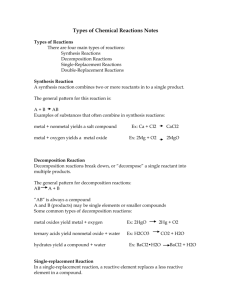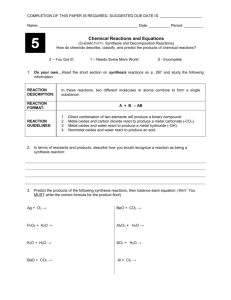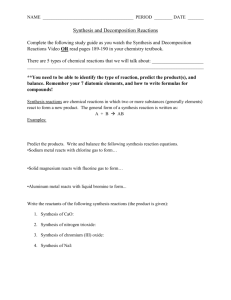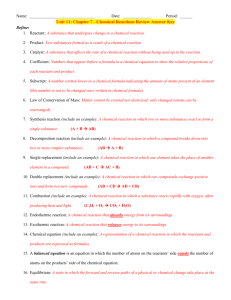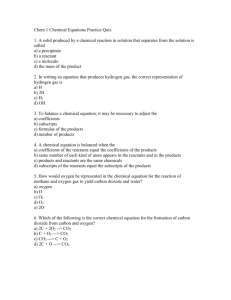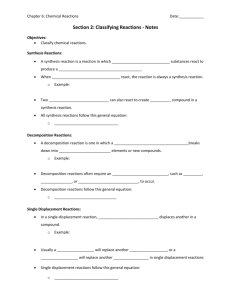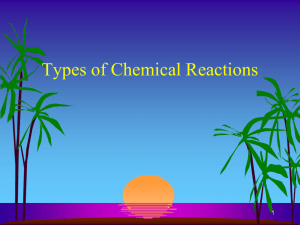Synthesis Reaction
advertisement
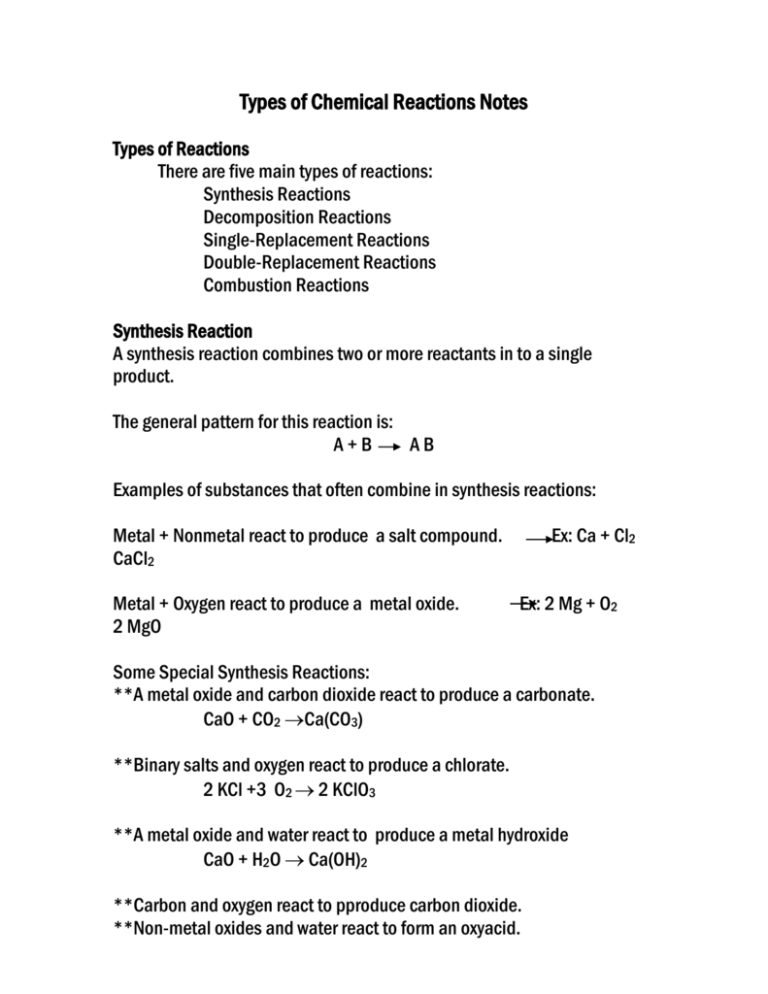
Types of Chemical Reactions Notes Types of Reactions There are five main types of reactions: Synthesis Reactions Decomposition Reactions Single-Replacement Reactions Double-Replacement Reactions Combustion Reactions Synthesis Reaction A synthesis reaction combines two or more reactants in to a single product. The general pattern for this reaction is: A+B AB Examples of substances that often combine in synthesis reactions: Metal + Nonmetal react to produce a salt compound. CaCl2 Metal + Oxygen react to produce a metal oxide. 2 MgO Ex: Ca + Cl2 Ex: 2 Mg + O2 Some Special Synthesis Reactions: **A metal oxide and carbon dioxide react to produce a carbonate. CaO + CO2 Ca(CO3) **Binary salts and oxygen react to produce a chlorate. 2 KCl +3 O2 2 KClO3 **A metal oxide and water react to produce a metal hydroxide CaO + H2O Ca(OH)2 **Carbon and oxygen react to pproduce carbon dioxide. **Non-metal oxides and water react to form an oxyacid. Ex. SO2 + H2O H2SO3 Decomposition Reaction Decomposition reactions break down, or “decompose” a single reactant into multiple products. The general pattern for decomposition reactions: AB A + B “AB” is always a compound A and B (products) may be single elements or smaller compounds Some common types of decomposition reactions: Metal Oxides decompose (break down) to produce a metal + oxygen Ex: 2 HgO 2 Hg + O2 Ternary acids (non-metal with hydrogen and oxygen) decompose (break down) to produce a nonmetal oxide + water Ex: H2CO3 CO2 + H2O Special Decomposition Reactions: ** Carbonates decompose (break down) to produce an oxide and carbon dioxide. Ex. CaCO3 CaO + CO2 **Chlorates decompose (break down) to produce a binary salt and oxygen. Ex. 2 Ba(ClO3)2 2 BaCl2+3 O2 Single-replacement Reaction In a single-replacement reaction, a reactive element replaces a less reactive element in a compound. The general pattern for single-replacement reactions: A + BX B + AX A = reactive element The B in BX is less reactive than A. Common single-replacement reactions: *More active metal replaces the less active: Zn + CuCl2 Cu + ZnCl2 *Metal replaces the H in an acid: Mg + 2HCl MgCl2 + H2 *More active halogen replaces less reactive: Cl2 + 2NaBr 2NaCl + Br2 Single-replacement reactions occur because the element that does the replacing is a more active element, based on its tendency to lose or gain electrons. To determine whether or not a single-replacement reaction will occur, refer to the “activity series.” (t his is in the front cover of your notebook) If the free element is above the other (in the compound) on the activity series, a reaction will occur. If the free element is below the other on the activity series, a reaction will not occur. Will a Reaction Occur? Au (s) + NaCl (aq) ? Zn (s) + H2SO4 ? Cl2 (g) + MgBr2 ? Mg (s) + Ca(OH)2 ? Double-Replacement Reactions In a double-replacement reaction, two compounds switch partners. The general pattern of this reaction: AY + BX AX + BY Most double-replacement reactions take place when both reactants are aqueous (dissolved in water). When two aqueous compounds are mixed, and partners “swap,” a precipitate is often formed. Example: Ex. Pb(NO3)2 + K2CrO4 PbCrO4 + 2 KNO3 Another example double-replacement reaction: Ex. HCl + KOH H2O + KCl Follow this series of questions. When you can answer "yes" to a question, then stop! 1) Does your reaction have oxygen as one of it's reactants and carbon dioxide and water as products? If yes, then it's a combustion reaction 2) Does your reaction have two (or more) chemicals combining to form one chemical? If yes, then it's a synthesis reaction 3) Does your reaction have one large molecule falling apart to make several small ones? If yes, then it's a decomposition reaction 4) Does your reaction have any molecules that contain only one element? If yes, then it's a single displacement reaction 5) If you haven't answered "yes" to any of the questions above, then you've got a double displacement reaction
